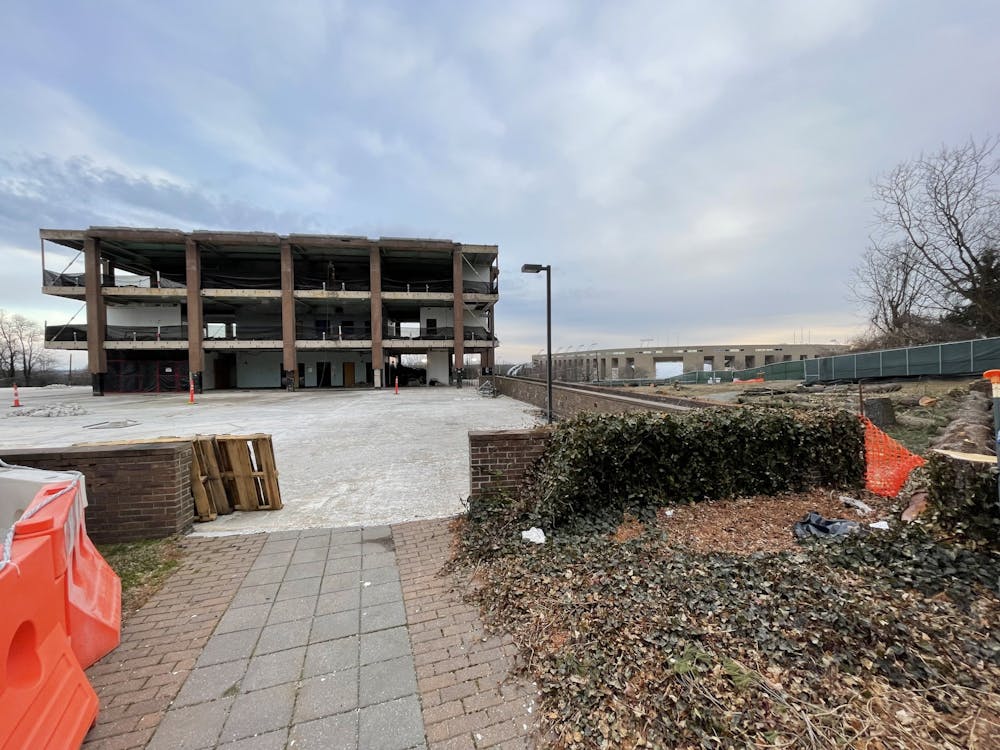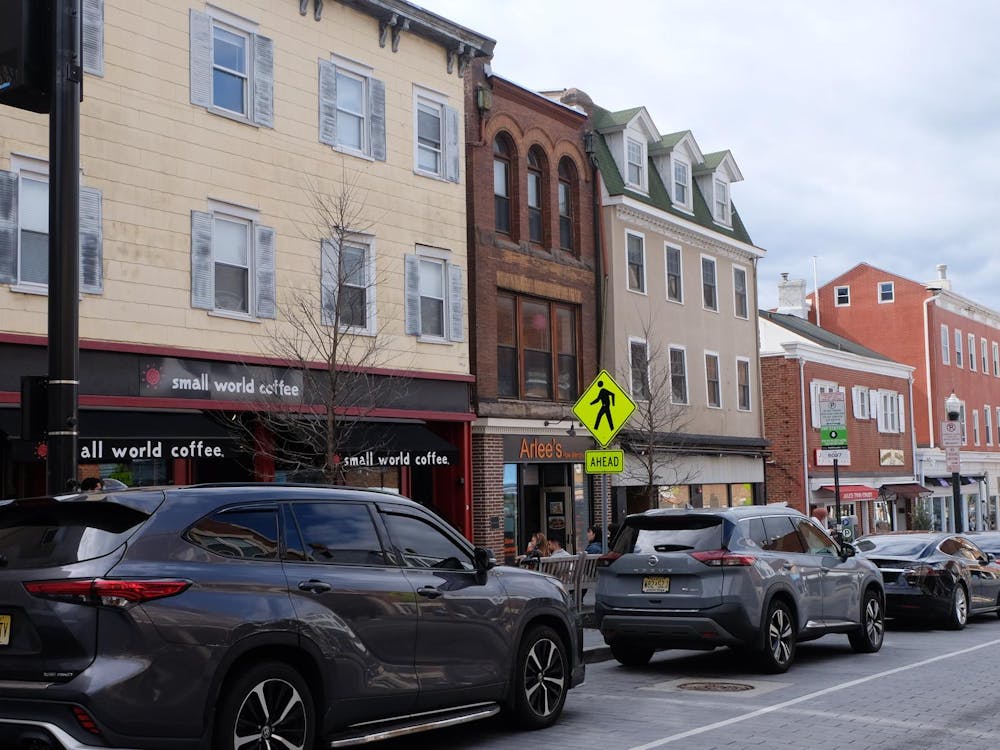As the University undergoes “one of the most extensive building programs in its history,” large portions of central and east campus are being fenced off and excavated.
Many of these sites are for the University’s conversion to hot water heating. But many other locations under current or future development are for the construction of new buildings, including the new School of Engineering and Applied Science (SEAS) neighborhood, Princeton University Art Museum, Roberts Stadium, and East Garage.
Construction is due to expand over the summer, including a new University Health Services (UHS) center, a temporary dining hall for Butler College, and an additional geo-exchange field in front of Whitman College.
Hot Water Distribution
The most extensive of these construction projects is the University’s new hot water distribution system, which will replace steam as the chief method for distributing heat on campus.
In an email to The Daily Princetonian, University Project Communication Manager Karen Fanning explained that this is a multi-step process, involving “hot water upgrades to the existing central plant, installing new geo-exchange bore-fields, running new distribution piping throughout campus; and building the Thermally Integrated Geo-Exchange Resource (TIGER) facility and Thermally-Integrated Geo-Exchange Resource Central Utility Building (TIGER-CUB) facility, which will house the heat pumps, as well as electrical equipment and thermal energy storage tanks that will run the system.”
The new distribution piping is responsible for many of the smaller fenced off sites around campus, such as the excavation south of Prospect Gardens, along Goheen Walk, between Clark Field and Princeton Stadium, and on Poe and Pardee fields.
Many of the hot water distribution sites will soon be evolving. For instance, the work south of Prospect Garden, according to Fanning, is “anticipated to be completed by the end of March,” restoring access to the pathway from Feinberg Hall to Frist Campus Center.

However, because these sites are for laying pipes, new excavation will often pick up where the last left off. The Prospect Garden site will lead to new excavation on the southern corner of the same quad, in order for the hot water system to reach McCosh Health Center.
The excavation along Goheen Walk in front of Scully Hall will soon extend to Yoseloff, Wilcox, and Wu Halls, and later, to 1976 Hall. Fanning wrote that the Goheen site “will be completed in early April.” In the interim, a “temporary asphalt pathway” has been constructed adjacent to the site in order to maintain accessibility.
Poe and Pardee fields currently have some of the most extensive hot water distribution sites. According to Ron, an employee of the University Civil Engineering and Construction department, these pipes will serve New Colleges East and West, Carl Icahn Laboratory, and Princeton Neuroscience Institute (PNI). Icahn Laboratory and the PNI, in particular, will require new fence-lines to be erected across Pardee Field. The Poe and Pardee field site is expected to be completed before Commencement 2022.
Most of the hot water sites have occurred on shale, which Fanning described as a “rippable” rock, as it can be dug up with an excavator.

Ron reported that construction crews have encountered veins of brownstone that require a hydraulic hammer or blasting to get through. These procedures have been responsible for the majority of the noise produced by the hot water sites.
According to Fanning, the location and depth of these brownstone veins vary throughout campus, so they cannot always be anticipated and “may cause delays to a project.”
According to Dave, a construction worker at the Lewis Library site, laying the hot water distribution system is a precise job, requiring the proper alignment of carbon steel pipes. Large amounts of sand aggregate are then trucked in to fill the trench, followed by topsoil to complete the dig.
East Campus
This hot water distribution system will be fed by new geo-exchange bore fields, which are arrays of 650 to 800-foot boreholes. These holes will circulate water from the distribution system deep into the earth, where, depending on the weather, they can either deposit or retrieve heat for the campus. One such bore field is being drilled on East Campus, below East Garage and Roberts Stadium, both of which are also under construction.
In order to regulate the hot water system, as well as campus energy at large, the University is also building the TIGER above the geo-exchange on East Campus. Along with the machinery needed to regulate flow to the boreholes, TIGER will feature heat recovery chillers, backup hybrid coolers, and massive heating and chilled water storage tanks.
The sites for East Garage and Roberts Stadium are located adjacent to TIGER, forming one continuous construction zone from FitzRandolph Road to Princeton Stadium. According to University maps, access to Lot 21 and its surrounding facilities will be preserved via Faculty Road. The hot and chilled water generated on East Campus will be carried to areas in central campus via pipes laid between Princeton Stadium and Clark Field.
While this site currently limits access to campus athletic facilities, Fanning told the ‘Prince’ that East Stadium Drive — the road between Clark Field and Princeton Stadium — “is anticipated to re-open in fall 2022.”
One of the more significant projects is located between Prospect Avenue and Ivy Lane, behind the eating clubs. Staff lots four, five, and 25, as well as the old Computing Center, are currently in the process of being demolished. 91 Prospect, formerly the home for the Dean for Research, is being moved across Prospect Avenue.
This site will become the SEAS Neighborhood, a four-building complex that will house the departments of Environmental Sciences, Bioengineering, and Chemical and Biological Engineering, as well as the Engineering Commons.
Commenting on the future fate of the existing Engineering Quad and the departments within it, Fanning told the ‘Prince’ that the University “continues to evaluate future engineering needs, but no final decisions [regarding their use] have been made at this time.”
According to recent University press releases, the new SEAS neighborhood will be terraced into the hillside, with “entrances at the Prospect Avenue level as well as the Ivy Lane level.”
Because of these plans, the construction requires an immense amount of dirt to be removed from the location. According to construction workers on-site, the stream of trucks exiting the site from Ivy Lane is, in large part, carrying the dirt and rubble produced by the project.
Another construction site, located adjacent to the SEAS Neighborhood, is a small construction site at the corner of Ivy Lane and Washington Road. This site largely blocks the second-floor entrance of the Lewis Library, and is circumvented by a new asphalt path extending from Goheen Walk.
According to one construction worker working at the SEAS site who spoke with the ‘Prince,’ the excavation in front of Lewis Library will make way for several hot water distribution pipes, as well as chilled water pipes, and sewer mains.
Fanning added that “there are specialized services that are being coordinated for the ES & SEAS project that are more science-specific than a humanities or residential building.”
The construction adjacent to Lewis Library has faced various challenges and delays in the past month, including the weather. The construction worker elaborated on this, telling the ‘Prince’ that a combination of snow, rain, and ice has made the ground difficult to work with, especially in areas where the sun does not reach.
According to Fanning, the pipes laid in front of Lewis Library are now largely complete, so excavation will now advance across Ivy Lane. While planning for this maneuver, however, contractors ran into wires for the building’s backup generator. To bypass those wires, contractors had to wait for permission from the University; as of last week, they were still waiting for electricians to work on the wires.
In order to maintain access to the construction site, contractors have installed a by-pass road in front of Lewis Library. According to Fanning, this by-pass road will be the main way for construction vehicles to access the SEAS site and will remain open until the project is completed in spring 2025. In the meantime, Western Way will re-open to traffic in fall 2022.
Fanning told the ‘Prince’ that, due to this by-pass road, “the construction fence-line will remain in front of Lewis Library, limiting access to Lewis [Library] directly from Ivy Lane.
“However [the University is] looking for opportunities to create a more direct temporary pathway from the east sidewalk along Washington Road to the front of Lewis Library,” Fanning said. “Flaggers will remain in place on either side of the by-pass road to monitor and help direct pedestrians.”
Future Construction
Amidst current construction projects around campus, several new projects are due to begin over the summer. According to a University presentation, five projects will commence in summer 2022. These include the expansions to Dillon Gymnasium, additional UHS facilities, a temporary dining hall for Butler College, and demolition of First College.
Parts of Dillon Gym will be demolished and surrounding areas will be excavated in preparation for its expansion. Construction on the facility will extend through Q1 of 2025.
Work on Hobson College will also begin over the summer, including the demolition of First College and site leveling for additional geo-exchange bores. This phase of the project is projected to be completed by Q2 of 2023, at which point construction on the new buildings will begin. This project will consume all of First and parts of Butler Colleges, extending from Goheen Walk in the South to 1937 Hall in the north, and from Elm Drive in the west to Guyot Hall in the east. Adjacent to this site, the University will construct an interim dining hall for Butler College intended to replace the demolished Wilcox dining Hall; this project will extend through the second half of 2022.
Across Elm Drive, the University will establish another new geo-exchange bore field on the lawn of Whitman College, in front of Community and 1981 halls. The majority of this excavation, including the boring of the wells, will occur over the summer of 2022. By fall 2022, the lawn will be regraded and reseeded.
Lastly, work will begin this summer on a new UHS facility, located where 1938 Hall, Eno Hall, and the Rock Magnetism Laboratory is now; the demolition of these buildings is anticipated to be completed by fall 2022, and the project, an expansion and renovation of Eno Hall, will be tentatively completed by Q2 of 2024.
Sullivan Meyer is a staff writer for the ‘Prince.’ He can be reached at shmeyer@princeton.edu or at @sullymeyer4 on Twitter.








